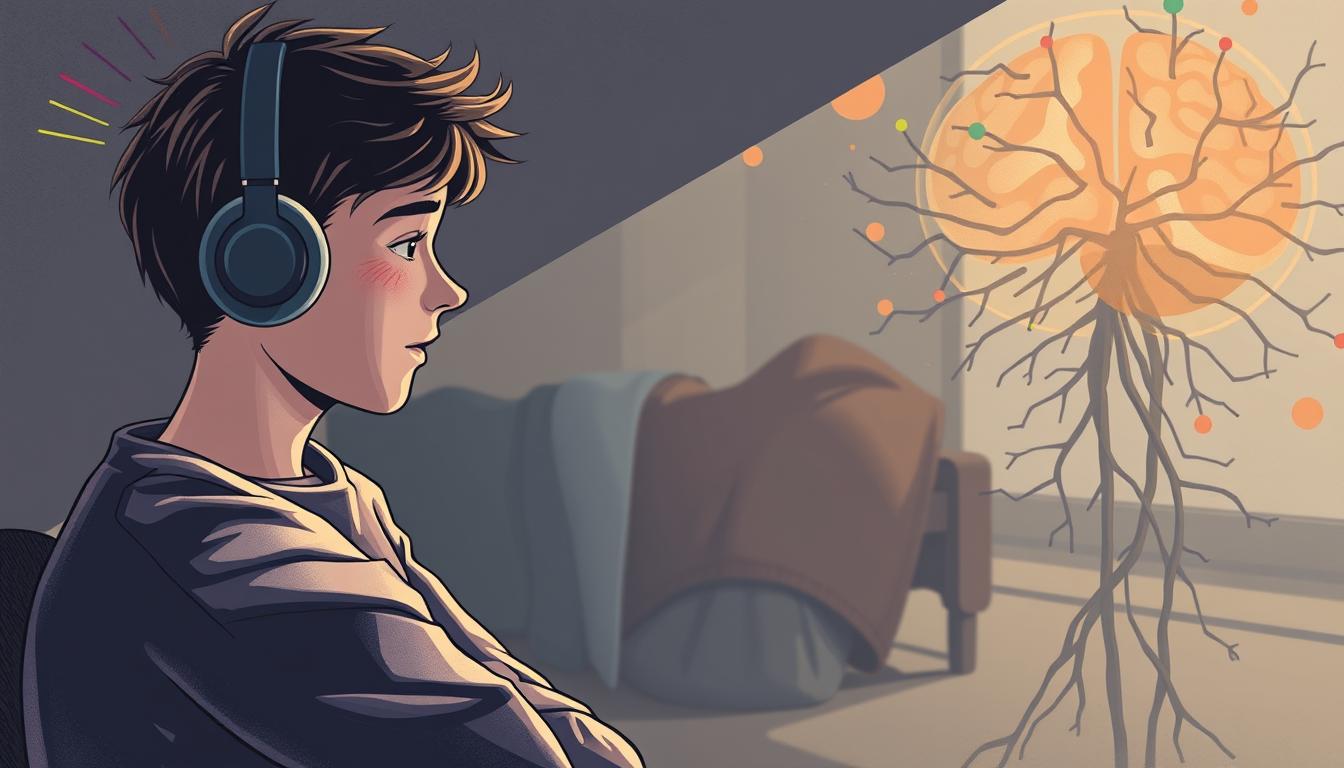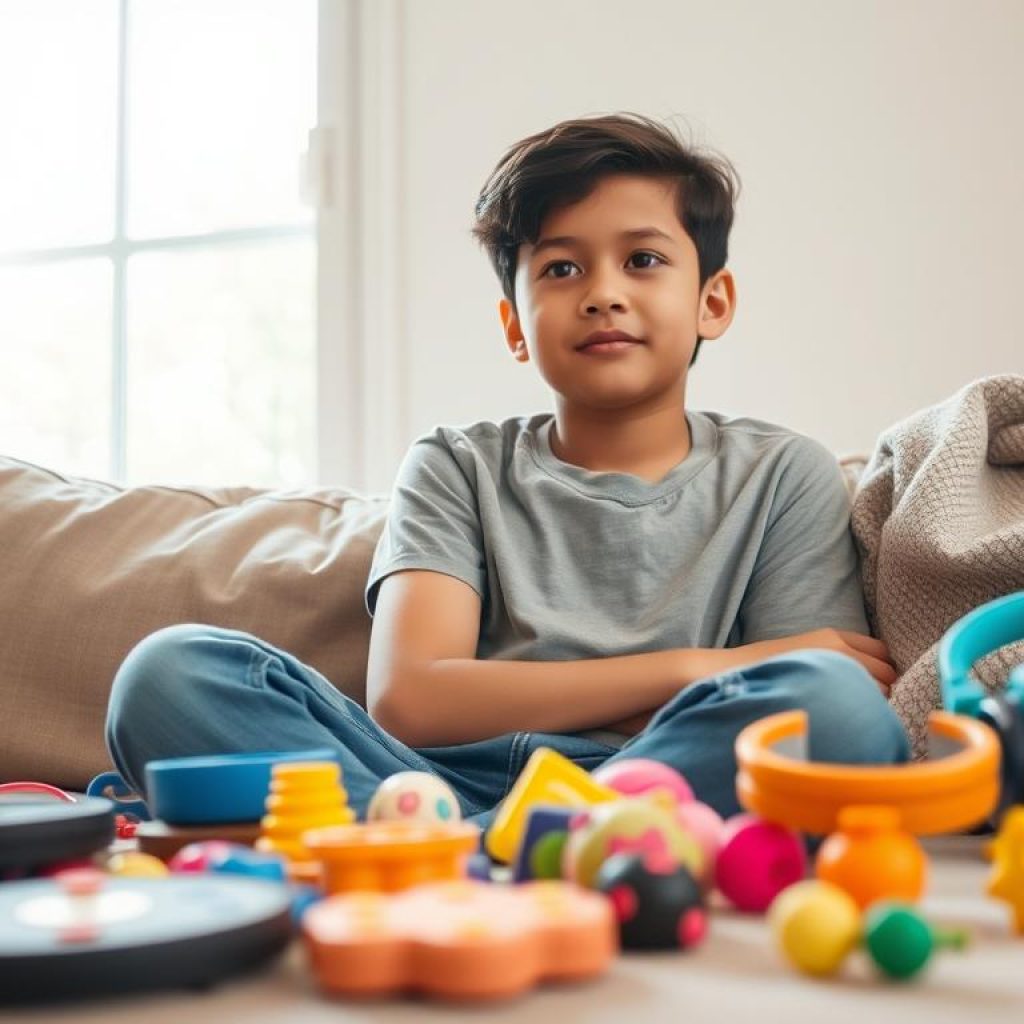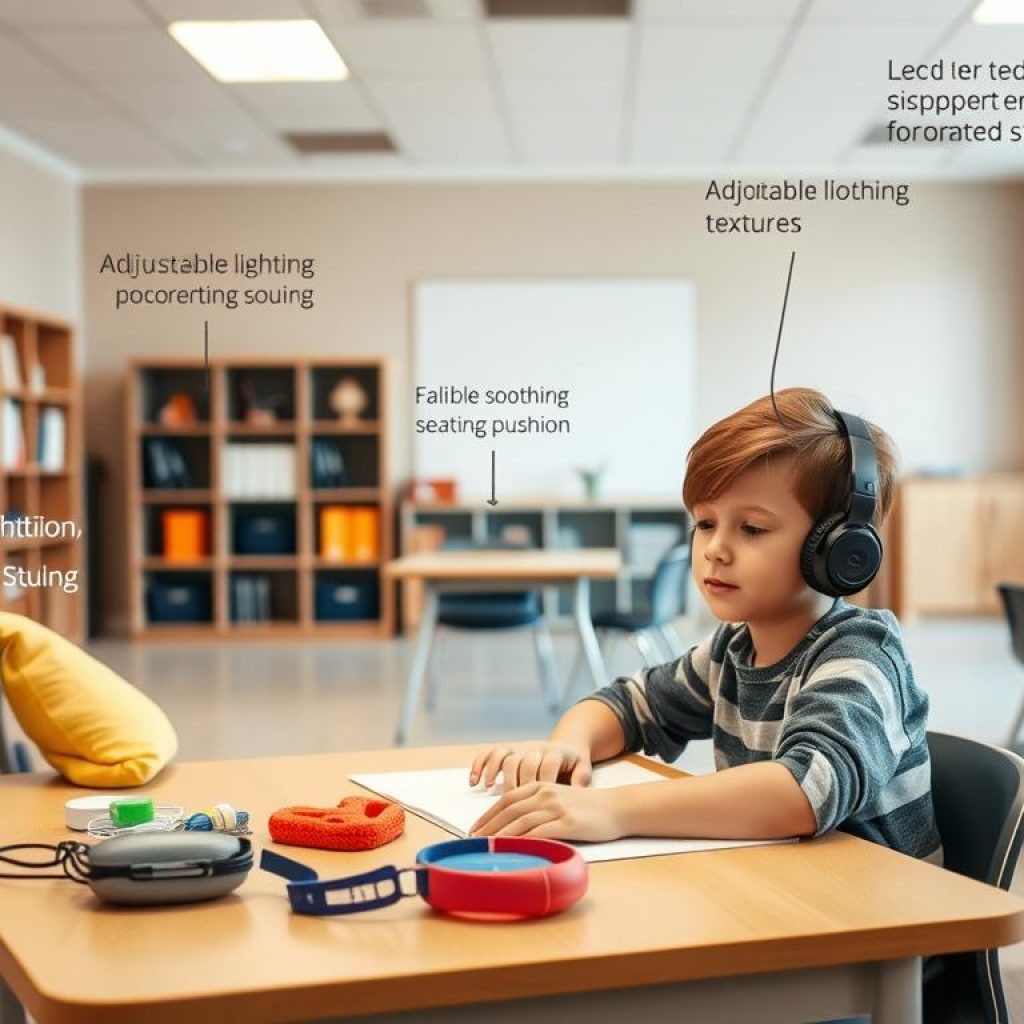- Send Us Inquiry info@autismworld.org.uk
- Emergency Help: +44 7938 641964

- May 28, 2025
- Articles, Autism
- Autism World
- 34 Comments
Did you know over 90% of autistic individuals experience differences in how they perceive everyday stimuli? For many, a flickering light or a crowded room isn’t just inconvenient – it can feel overwhelming or even painful. These reactions stem from variations in how their brains interpret sensory information, creating unique challenges that shape daily life.
Neurodivergent people often navigate the world with heightened or reduced sensitivity to sounds, textures, or smells. Some might cover their ears at a kettle’s whistle, while others seek out intense physical pressure for comfort. Recognising these extremes – known as hypersensitivity and hyposensitivity – is crucial for building supportive environments.
This guide explores practical strategies for managing these experiences, drawing on insights from UK-based specialists and lived experiences. We’ll examine how sensory systems function differently, affecting everything from clothing choices to social interactions. Our focus remains on actionable solutions that prioritise wellbeing without demanding conformity.
Whether you’re a parent, teacher, or autistic adult, understanding these nuances fosters empathy and effective support. By embracing neurodiversity, we can create spaces that accommodate varied needs while celebrating individual strengths.
Introduction: The Importance of Understanding Sensory Processing in Autism
Many neurodivergent individuals experience the world through distinct neurological frameworks that shape their interactions. These differences often manifest in how they interpret sights, sounds, and textures, influencing behaviours and preferences. Grasping these variations helps dismantle misconceptions while fostering inclusive practices.

Core Concepts Explained
Sensory processing refers to how our nervous system receives and responds to environmental stimuli. For autistic people, this mechanism may amplify or dampen signals unpredictably. A child might find clothing tags unbearable, while an adult could struggle with background chatter in cafés.
Building Awareness Nationally
UK schools and healthcare services increasingly prioritise training to identify atypical responses early. Timely recognition allows tailored support, such as quiet spaces or flexible learning tools. Public campaigns also challenge stereotypes, promoting acceptance of diverse needs.
Families report improved wellbeing when communities adapt to individual requirements. Simple adjustments – like reducing fluorescent lighting in shops – make public spaces more accessible. This cultural shift empowers neurodivergent individuals to thrive without masking their authentic selves.
Sensory Processing in Autism: An Overview
For many families across the UK, daily life involves navigating how their child interacts with sights, sounds, and textures. These experiences often differ significantly from neurotypical perceptions, creating unique challenges in homes, schools, and public spaces. Environmental factors – from buzzing classroom lights to crowded supermarkets – can trigger intense reactions or withdrawal behaviours.

Recognising these variations is now an integral part of autism diagnoses. Clinical assessments evaluate responses to stimuli like clothing fabrics or background noise. Some individuals might crave deep pressure, while others avoid physical contact entirely. This spectrum of responses highlights why personalised support matters.
Broader societal elements also shape experiences. Public transport announcements or flickering shop displays often lack consideration for those with heightened sensitivity. Conversely, structured environments with predictable routines tend to reduce stress. UK schools increasingly use visual timetables and noise-cancelling headphones to help pupils focus.
Every autistic person’s profile remains distinct – one child might struggle with food textures but enjoy loud music, while another finds fluorescent lighting unbearable. These differences underscore why flexible approaches work best. Upcoming sections will explore practical methods for managing specific sensitivities while respecting individual needs.
Sensory Sensitivities and Their Impact on Daily Life
Navigating daily environments can pose unique hurdles for those with distinct sensory profiles. Responses to stimuli vary widely – while some people recoil from certain textures, others barely register them. These differences profoundly influence routines, relationships, and overall wellbeing.

Hypersensitivity vs. Hyposensitivity
Hypersensitivity amplifies input, making ordinary stimuli overwhelming. Think of a child covering their ears in a noisy café or refusing scratchy jumpers. Conversely, hyposensitivity involves under-responsive systems, requiring stronger input for registration. An adult might seek intense exercise to feel grounded or chew objects unconsciously.
Real-life Examples and Effects
Consider a teenager avoiding crowded buses due to perfume sensitivities. Their body reacts with headaches, forcing schedule changes over time. Another example: a chef struggling with kitchen clatter may develop chronic fatigue from constant sensory bombardment.
These challenges affect coordination and environmental interactions. Children might trip frequently if distracted by buzzing lights. Adults could miss social cues while managing discomfort. Busy periods – like holiday shopping – often exacerbate dysregulation, testing coping strategies.
Recognising these patterns helps tailor support. Occupational therapists emphasise personalised approaches, whether through weighted blankets or noise-filtering earplugs. Addressing individual needs fosters resilience, enabling fuller participation in daily activities.
Addressing Hypersensitivity and Hyposensitivity
Everyday environments can become battlegrounds for those with heightened or reduced sensitivity to stimuli. Practical adjustments help mitigate overwhelming experiences, enabling individuals to navigate spaces with greater confidence. Tailored approaches balance immediate needs with sustainable solutions.

Managing Sensory Overload
Reducing environmental triggers is key. Dimming harsh lights or using lamps with warm bulbs eases visual strain. Noise-cancelling headphones offer instant relief in bustling areas like supermarkets or public transport. Portable tools – fidget spinners or textured objects – provide discreet grounding during stressful moments.
Strategies for Reducing Dysregulation
Creating a dedicated calm space at home or work enhances the ability to self-regulate. This area might include weighted blankets, soft seating, and minimal sensory input. Occupational therapists often recommend “sensory diets” – scheduled activities like swinging or compression clothing – to maintain equilibrium.
Short-term fixes, such as carrying ear defenders, address sudden discomfort. Long-term plans might involve adapting routines: shopping during quieter hours or using blackout curtains. Crucially, strategies must align with personal experiences – a solution for one person could cause pain for another.
Schools and workplaces across the UK increasingly adopt these ways of supporting neurodivergent individuals. Flexible seating arrangements and breakout zones in classrooms demonstrate how small changes make shared spaces more inclusive. By prioritising individual needs, communities foster environments where everyone can thrive.
Understanding Interoception, Proprioception and Vestibular Sensitivity
Beyond the five traditional senses lie three critical systems shaping how we experience our bodies and surroundings. Interoception governs internal signals like hunger or discomfort. Proprioception coordinates movement through joint and muscle feedback. Vestibular sensitivity affects balance and spatial orientation. Many face challenges with these sensory processing issues, impacting daily life in overlooked ways.

The Role of Interoception in Sensory Processing
Recognising bodily cues proves difficult when interoceptive levels fluctuate. Someone might miss thirst signals until dehydrated or struggle to identify pain sources. Occupational therapists use tools like body scan exercises to improve awareness. Checklists for regular meals or bathroom breaks offer practical support, especially for children developing self-regulation skills.
Supporting Vestibular and Proprioceptive Challenges
Rocking chairs or balance boards help those with vestibular differences feel grounded. Weighted vests or resistance activities address proprioceptive needs, enhancing body awareness. UK specialists often recommend Sarah Lloyd’s book ‘Making Sense of Your Senses’ for home strategies.
Training modules from organisations like the National Autistic Society equip caregivers with tailored approaches. Addressing these sensory processing issues holistically improves independence and quality of life. Small adjustments – like movement breaks during lessons – make substantial differences at various levels of need.
Personal Experiences and Variability in Sensory Responses
Imagine walking into a room where every sound feels like a shout and textures scratch like sandpaper – this is daily reality for some autistic individuals. Responses to stimuli differ so widely across the autism spectrum disorders that no two people share identical profiles. These variations demand personalised approaches to care and environmental design.

Unique Sensory Profiles Among Autistic Individuals
One child might find fluorescent lights unbearable yet seek out strong hugs for comfort. Another could struggle with food textures but enjoy loud concerts. Such contrasts highlight why standardised solutions often fail. Tailored sensory integration techniques – like structured play or adaptive tools – address specific needs effectively.
| Profile Type | Common Characteristics | Support Strategies |
|---|---|---|
| Heightened Sensitivity | Overwhelmed by crowds, bright lights, or certain fabrics | Noise-cancelling headphones, dimmed lighting |
| Reduced Sensitivity | Seeks intense movement, pressure, or flavours | Weighted blankets, chewable jewellery |
| Mixed Responses | Combines hyper- and hypo-sensitivities across senses | Customised sensory diets, flexible environments |
How individuals process sensory information shapes their interactions with the world. A teenager might misinterpret hunger cues due to interoceptive differences, while an adult could miss social signals when managing discomfort. These sensory issues underscore the need for compassionate, individualised support systems.
UK specialists emphasise that recognising sensory differences improves outcomes in education and employment. Schools using multi-sensory rooms report fewer meltdowns, while workplaces offering adjustable lighting see higher productivity. By centring personal experiences, communities can move beyond one-size-fits-all solutions.
Environmental Adaptations and Sensory Support Strategies
Creating supportive spaces transforms daily experiences for those navigating sensory differences. Simple adjustments to surroundings can significantly reduce overwhelming sensory input, particularly across the autism spectrum. From classrooms to supermarkets, thoughtful design helps individuals engage more comfortably with their environment.

Adjusting Lighting, Noise and Visual Distractions
Harsh fluorescent lights or buzzing electronics often trigger discomfort. Switching to warm-toned LED bulbs with dimmers eases visual strain. Noise-reducing panels in classrooms or ear defenders for shopping trips help manage auditory overload.
Visual clutter poses another challenge. Clear labelling systems and neutral-coloured walls create calmer spaces. A child may focus better when their study area has minimal posters and organised storage.
Tailoring Daily Routines and Spaces
Predictable routines provide stability. Visual timetables with pictograms help prepare for transitions between activities. Designated quiet corners with bean bags or weighted blankets offer retreats during overwhelming moments.
Collaborating with occupational therapists ensures adaptations match individual needs. For example, a pupil with vestibular system differences might benefit from movement breaks between lessons. Schools often use wobble cushions or standing desks to support focus.
| Environment | Adaptation | Benefit |
|---|---|---|
| Home | Blackout curtains | Reduces light sensitivity during sleep |
| School | Noise-filtering earplugs | Helps concentration in busy corridors |
| Workplace | Adjustable desk lamps | Allows personalised lighting control |
These strategies demonstrate how understanding spectrum disorders leads to practical solutions. By prioritising individual comfort, environments become empowering rather than exhausting. Every small change contributes to better managing sensory input across daily life.
Coping Mechanisms and Professional Guidance
Tailored support transforms how autistic individuals manage daily challenges. From noise-reducing headphones to structured routines, practical tools help navigate overwhelming environments. Professional guidance plays a pivotal role in developing these personalised approaches.
The Benefits of Occupational Therapy
Occupational therapists specialise in assessing sensory profiles to address unique needs. They might recommend weighted blankets for calming or design movement breaks to regulate energy levels. One case study involves a child who gained confidence using a tactile brush routine before school.
Immediate coping strategies often include:
- Carrying fidget tools to manage sudden sensory sensitivity
- Using apps to predict noisy environments
- Practising grounding techniques during overload
Long-term solutions focus on adapting environments. Schools might introduce flexible seating, while workplaces adjust lighting schemes. The National Autistic Society highlights success stories where early intervention reduced processing issues over time.
| Approach | Purpose | Outcome |
|---|---|---|
| Sensory Diets | Balance input throughout the day | Improved focus in classrooms |
| Environmental Audits | Identify triggers in spaces | Fewer meltdowns at home |
| Skill-Building Workshops | Teach self-advocacy techniques | Increased independence in adults |
For those on the spectrum disorder, combining professional support with personal experimentation yields the best results. Regular check-ins ensure strategies evolve alongside changing needs, fostering resilience across life stages.
Conclusion
Holistic approaches that consider both emotional and physical needs yield the most sustainable outcomes for managing sensory experiences. This guide has highlighted how tailored strategies – from environmental adjustments to occupational therapy – empower individuals to navigate daily life with greater confidence. Recognising unique profiles ensures support respects personal boundaries while fostering independence.
Families and professionals may also explore tools like visual schedules to help children process sensory challenges effectively. Weighted accessories or noise-reducing headphones may also provide relief in overwhelming settings. Continuous collaboration with specialists remains vital, adapting techniques as needs evolve.
Prioritising awareness body cues strengthens self-regulation skills, whether through mindfulness practices or structured movement breaks. Readers are encouraged to seek UK-based resources, such as National Autistic Society workshops, for personalised guidance. By valuing individual differences, we create environments where everyone can thrive on their own terms.
